Back to page 1
The Essentials
Admittedly, the game-day experience for a Rays’ spring-training game might be a little different than a regular-season game for the Charlotte Stone Crabs. The facility is the same, but the jammed stands and exuberance of a Major League exhibition in March is likely to be more festive than a Florida State League contest in July with the stands half-full.
Everyone expects the Stone Crabs to do well, and possibly top the FSL in attendance. Understand, though, that this league has different expectations for attendance than others around the country. Indeed, a season total in six figures is cause for celebration. That means that even a well-attended regular-season contest in Port Charlotte won’t have nearly the crowd of a Rays spring fling. It won’t hurt that Cal Ripken is involved in the Stone Crabs as an owner, and that kind of “star power” often translates to extra ticket sales.
But the lovely, comfortable facility will be the same whether it’s a spring exhibition or a minor-league regular-season game. The game-day experience as provided by the park’s features and staff should be somewhat similar though, especially in the park’s inaugural year.
For the spring games, parking costs $7, whether you park in the 1,500-space lot on the ballpark side of El Jobean Road or you are directed across the street to the fairgrounds’ lots. If you have a choice, try to stay in the left lane as you’re heading west on El Jobean to increase your odds of being directed to the main parking area. I doubt that the lot at the fairgrounds will be needed for most of the Stone Crabs’ games, though.
Tickets for the spring exhibitions are pretty pricey at $18 and $23 for boxes, and $18 and $16 for reserved seats … but that certainly hasn’t hurt demand, though. Thanks to robust “season ticket” sales, all permanent seats were sold out for 2009’s games before any single-game tickets went on sale in January. That left just general-admission tickets, which cost $9. For the minor league team’s regular season, tickets are $9, $8 and $7.
 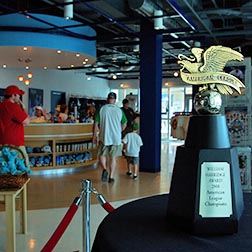 |
The souvenir store (above left) is to die for. Thanks to the significantly expanded main building right behind home plate, the ground-floors’ 2800-square-foot retail outlet is both spacious and gorgeous. And not that the team was boasting or anything, but during the spring, the American League Championship Trophy for 2008 was on display for all to see (above right).
The merchandise selection was extensive, perhaps even topping the Yankees in Tampa (but not the ridiculous amount of Red Sox merchandise in Fort Myers), and it was beautifully displayed. There are plenty of caps and kids apparel, and my favorite ballpark souvenir, lapel pins, was well represented. The prices were about what you would expect, with adult T-shirts starting at about $24.
When you look at the food offerings at the concession stands, you might be a little surprised to see some “brand name” items. There are Chick-fil-A sandwiches for $4.50 and Quiznos’ subs for $6.00. Of course, you’ll also find your typical hamburgers ($4.75) and jumbo hot dogs ($4). Most beers are $5.50. Note that the springtime games are featuring free-standing food kiosks that are likely to be absent during the regular season.
While you’re watching the game, you’ll note that the scoreboard is nothing to write home about. There’s no video screen and only a small, bare-bones message area at the bottom of the board that displays who’s at bat. This might be an area for the Rays to upgrade in coming years.
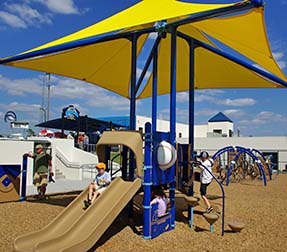  |
Next to the boardwalk, my favorite feature hands-down is the play area for kids off the concourse behind first base. It’s easily the nicest at a spring training park, and rivals what most big-league stadiums provide. Melanie Lenz told me that a focus group of sorts was convened to determine what the play area should include. That group, made up of local kids, declared that there should be separate areas for younger kids and older kids, based on the reasoning that the playground equipment for the two groups would be quite different, plus big kids don’t like playing alongside little kids and vice versa.
Their suggestions were carried out perfectly. The play area for the younger set (above left) is decked out with shaded slides, while the older kids get an ingenious apparatus designed to encourage physical activity (above right).
One aspect of the kids area that I didn’t like at all was the fact that beer was being served at the Kids Clubhouse concession stand, right next to the playground. It appears that this wasn’t the original plan, as the pre-printed menus (below right) behind the servers did not include beer. However, “16 oz. bottle beer” for $5.50 is now crudely written on the board. I understand that dads watching their youngsters at the playground might like a cold one, but I still think this is a bad idea on a number of levels.
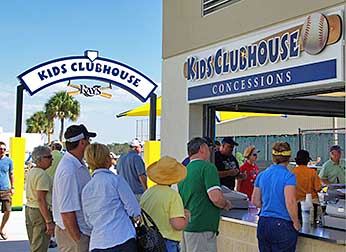 |
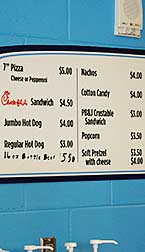 |
One last thing about the experience of attending a game here … make an effort to walk all around both the outside and the inside of the park, paying special attention to the “look” of the park and the grounds. You’ll quickly notice the wonderful landscaping outside and inside the facility, which is (admittedly) a hallmark of an HOK-designed facility. It might not quite be at the level of the $4 million of landscaping at the new Camelback Ranch spring-training complex in Glendale, AZ (which, to be fair, houses two Major League teams and had an unbelievably high budget), but it is still very impressive and well-thought-out.
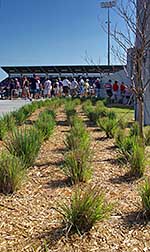 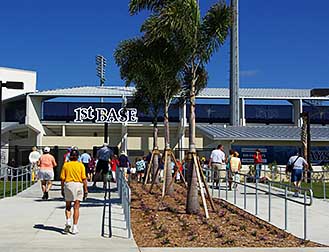 |
Summary
So Charlotte Sports Park is a quantum leap forward from the Charlotte County Stadium the Rangers used through 2002. By retaining the sound “guts” of that park, HOK and the Rays transformed it into something that is much, much more comfortable and visually appealing.
 |
So how does this ballpark now compare to other Grapefruit League facilities? Very well. It’s a nice, intimate size (unlike huge Steinbrenner Field in Tampa), and the main seating bowl and boardwalk (somewhat similar to Clearwater’s walk-around concourse and tiki bar) are great. Compared to the big-money projects in Arizona, well, it’s not quite at that level. Surprise, the expanded Scottsdale, Goodyear and especially Glendale all raised the bar above any of the Sunshine State’s parks.
Of course, I’ve always preferred spring training in Arizona to Florida — for the more-predictable weather, proximity of teams, scenery, wealth of dining and lodging options … plus the average Arizona park is just a little nicer than the average one in Florida. Charlotte Sports Park, though, has definitely raised Florida’s average. And the city of Port Charlotte still might not be at the top of my vacation-destination list, but this ballpark gives baseball fans a very big reason to visit this town.